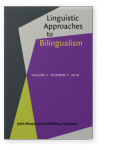Commentary
Relative language proficiency affects language production in unimodal and bimodal bilinguals
References (18)
References
Bishop, M., & Hicks, S. (2005). Orange eyes: Bimodal bilingualism in hearing adults from Deaf families. Sign Language Studies, 51, 188–230. 

Grosjean, F. (1989). Neurolinguists, beware! The bilingual is not two monolinguals in one person. Brain and Language, 361, 3–15. 

Ivimey, G.P. (1981). The production and perception by profoundly deaf children of syntactic time cues in English. British Journal of Educational Psychology, 51 (1), 58–65. 

Li, P., Legault, J., & Litcofsky, K. A. (2014). Neuroplasticity as a function of second language learning: Anatomical changes in the human brain. Cortex, 581, 301–324. 

Quigley, S.P., & King, C.M. (1980). Syntactic performance of hearing-impaired and normal hearing individuals. Applied Psycholinguistics, 11, 329–356. 

Quigley, S. P., Power, D. J., & Steinkamp, M. W. (1977). The language structure of deaf children. Volta Review, 791, 73–84.
Singleton, L., Morgan, D., Di Gello, E., Wiles J., & Rivers, R. (2004). Vocabulary use by low, moderate, and high ASL-proficient writers compared to ESL and monolingual speakers. Journal of Deaf Studies and Deaf Education, 91, 86–103. 

Taeschner, T., Devescovi, A., & Volterra, V. (1988). Affixes and function words in the written language of deaf children. Applied Psycholinguistics, 91, 385–401. 

Tur-Kaspa, H., & Dromi, E., 2001, Grammatical deviations in the spoken and written language of Hebrew-Speaking children with hearing impairments. Language, Speech and Hearing Services in Schools, 321, 79–89. 

Van Beijsterveldt, L.M., & Van Hell, J.G. (2009). Evaluative expression in deaf children’s written narratives. International Journal of Language and Communication Disorders, 441, 675–692. 

Van Beijsterveldt, L.M., & Van Hell, J.G. (2010). Lexical noun phrases in texts written by deaf children and adults with different proficiency levels in sign language. International Journal of Bilingual Education and Bilingualism, 131, 439–468. 

Van Beijsterveldt, L.M., & Van Hell, J.G. (2012). The development of deaf writers’ tense marking in narrative and expository text: a bimodal bilingual perspective. Bilingualism: Language and Cognition, 151, 128–144. 

Van Hell, J.G., & Tanner, D. (2012). Second language proficiency and cross-language lexical activation. Language Learning, 621, 148–171. 

Wilbur, R.B., & Quigley, S.P. (1975). Syntactic structures in the written language of deaf children. Volta Review, 771, 195–203.
Williams, C., & Mayer, C. (2015). Writing in young deaf children. Review of Educational Research, 851, 630–666. 

Wolbers, K.A., Bowers, L.M., Dostal, H.M., & Graham, S.C. (2014). Deaf writers’ application of American Sign Language knowledge to English. International Journal of Bilingual Education and Bilingualism, 171, 410–428. 

